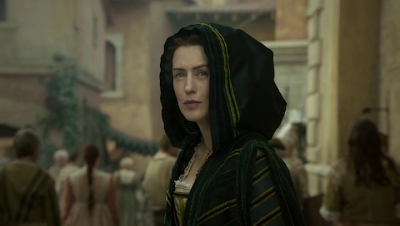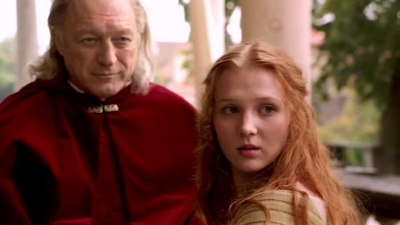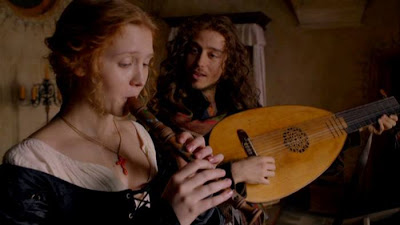St Peter as Pope by Rubens
Happy Easter everyone! I hope you're all having a lovely weekend and eating lots of chocolate. Given the theme of the day and my love of Papal history, I thought I'd do a piece on the supposed first Pope of Rome - St. Peter. Just a warning, given who he is this post will inevitably have to contain some very religious imagery and bible quotes - however it is my aim to provide a post that concentrates more on who he was, and the theories over both how he died, and whether or not he was actually in Rome. It should be said also that there are many more questions than answers when it comes to St Peter - however the theories that surround his life and death are incredibly fascinating.
Religious tradition dictates that Peter, or Simon as he was known before Jesus gave him the name of Peter, was one of Jesus' 12 apostles. He was the first apostle to be chosen by Jesus, and pretty much his best friend and right hand man. Tradition also tells us that Peter was a fisherman from Galilee and introduced to Jesus through his brother Andrew. According to Roman Catholic tradition, Peter ended up coming to Rome after the crucifixion of Jesus and founding the Catholic church that we know today - indeed there are portraits of him everywhere, and the seat of Christendom in Rome is even named after him. But why is this?
Who was Peter? Did he really go to Rome? Was he the first Pope?
So why does the Catholic faith consider Peter to be their first Pope? The answer is really very simple here - In the gospel of Matthew (XVI, 18-9), Jesus says to Peter:
"Thou art Peter, and on this rock I will build my church...I give unto thee the keys to the kingdom of Heaven"
These few words, inscribed around the top of St Peter's basilica in Rome, have been the subject of much debate over the centuries. When these words were uttered, Peter was not a name at all but the Aramaic word kephas translated into Greek as Petros - whick means rock or stone. However, there are differences between the gospels about whether this was uttered at all - Mark and John both mention it, however John's is mentioned much later, suggesting that it was added in at a much later date. Matthew is the only one who puts a particular reason into the words stated while the other gospels disagree about whether this actually happened or not.
It seems then, that the tradition that the church was founded on a rock (aka Peter) is pretty unlikely. Or is it? Tradition (I'm mentioning this word a lot, but there are reasons for it) states that Peter founded the church and so the Popes we know today are an infinite line of his successors.
In the New Testament, Peter becomes somewhat of an enigma after the death of Jesus. Indeed it mentions relatively little of either his fate or the fate of St Paul. Early tradition states that they were both in Rome when the Great Fire raged through the city in AD64. Following the fire, Nero wanted to find someone to blame, and so blamed the Christians - he was well known for his hatred and persecution of Christians, and is particularly famous for his special human candles. Tacitus tells us that after the great fire, Christian's were covered with animal skins and torn apart by dogs, nailed to crosses or set on fire. It is said that both Peter and Paul were killed during these persecutions but the Acts of the Apostles are really quiet on this subject. St Luke, who we know went with Paul to Rome, doesn't even mention Paul's martyrdom. Surely he would have done if they were working together? All Luke mentions, in the last few lines, is that he stayed in Rome for two years. Peter disappears from the story half way through chapter XII when we are told that he "departed, and went to another place". So if both Peter and Paul were martyred, why doesn't Luke mention it. Yet again, more questions than answers come out of this.
So Peter and Rome, then. Peter certainly had good reason to go to Rome, having been given his mission to spread the word of Jesus to the Jews. At the time he would have been in Rome, the majority of the Roman church was made up of Jews with 30-40,000 Jewish people living in the city at the time. But yet again, there is no evidence that Peter even went to Rome in the New Testament. When Paul wrote his epistle to the Romans in AD58, he didn't mention Peter at all and when, at the end he writes a list of names to who he's giving his greetings there's no mention of Peter. At all. So if he was in Rome, he can't have been there for very long. And those few years, if he was there, means that he wasn't there long enough to found the Roman Church which in any case has already existed for a good few years! As well as this, there is no contemporary reference to Peter being a bishop, or indeed of there being any bishop in Rome before the second century AD.
The Denial of St Peter by Caravaggio
What evidence is there though, that Peter was in Rome and met his fate at the hands of Nero's persecutors? The two most compelling pieces come from both Peter's own epistle, and a letter written by Clement (normally third or fourth in the list of Popes). In Peter's epistle, the penultimate verse states:
"She (the church) that is in Babylon...saluteth you."
But what does it mean? At the time, Babylon was a symbolic name for Rome and was used no less than four times in the Book of Revelation. The second piece of evidence comes from the letter written by Pope Clement in AD96 to the Church of Corinth. It seems that Clement knew Peter personally:
"Let us set before our eyes our good apostle Peter, who because of unrighteous jealousy suffered not one or two but many trials, and having thus given his testimony went to the glorious place which was his due."
Whilst written in a very roundabout way, this points to the fact that Peter suffered; that he was martyred - it doesn't mention the way it happened. Was he crucified? That's certainly what tradition (there's that word again) states that he was crucified upside down due to believing he wasn't worthy to die in the same way as Jesus. Clement then goes on to mention Paul in almost the same breath, and mentions Paul's martyrdom (beheading) which suggests that they met a similar fate. Alas, we will never be certain of how this happened. All we can be sure of is that by the middle of the second century AD, it was accepted that both Peter and Paul had been martyred in Rome. There were even two sites connected with their martyrdom. The one we are interested in is Vatican Hill, where Peter was said to have been martyred.
The Liberation of St Peter by Honthorst
In around 320AD, Emperor Constantine built the first St Peter's basilica upon Vatican Hill. Why? He was determined to build it there, on the site of an open cemetery that was full of bodies and ancient catacombs. As the basilica was being built, these graves and necropolis were destroyed. And all because Constantine wanted to build over the site where he was sure St Peter's bones lay. There is evidence too that suggests he was right! This is a piece of contemporary evidence from about AD200 in which the Roman historian Eusebius (quoting a Roman priest by the name of Gaius):
"If you go to the Vatican or to the Ostian Way, there you find the trophies (tropaia) of those who founded this church."
"Those who founded this church" is quite clear really, and it is the Vatican part of it we are interested in. We know Paul was executed on the Ostian Way so for the intents of this piece we can ignore it. The word tropaia refers to some sort of memorial to Peter that would have been visible on Vatican Hill. Excavations that took place after the Second World War at the Vatican actually found a two tiered three nieched construction known as an aedicula (normally used to hold sarcophagi), in front of which were earlier burials. This is actually incredibly significant. No sarcophagi were held in the aedicula so we have no way of knowing whether the burials were christian or pagan - what we do know is that bodies in Rome at that point were normally cremated, something which Christians did not do at the time. The aedicula held interred burials, human remains; in a corner of the cemetery which points to the fact it was an area of the cemetery reserved for those with different beliefs - probably Christians. There were also an unusually large number of votive coins found there, suggesting that this was a significant pilgrimage site. This is now believed to be the trophy mentioned by Gaius, and in the 1950's Pope Pius XII announced with confidence that this was the site of St Peter's burial. However there are some significant objections to this too:
- Peter was an uneducated fisherman from Galilee - and special burial was saved for important prisoners. As a man, not a member of the gentry, his body would have been thrown into the Tiber along with the other common criminals. Thus his body would have been very difficult to get hold of.
- If he did indeed meet his death during Nero's persecutions; given how Christians were executed at that time, his remains were even less likely to have survived.
So, does that mean this aedicula was more of a memorial than a mausoleum? Or were some of the human remains found actually the bones of Peter? And if so, was he buried there because of his work with Jesus even though he wasn't exactly highly sophisticated? If the remains did belong to Peter, then Matthew's testimony was correct - Peter really was a foundation stone of the church. Indeed the Roman Catholic Church believes it so wholeheartedly that they insist the line of Popes represent an uninterrupted line from St Peter even though, as we have already seen, Peter wasn't in Rome long enough to found the church and there's no evidence that says he was even a bishop.
The Crucifixion of St Peter by Caravaggio
It really is difficult to come to any sort of solid conclusions with the information that we have. We can be fairly certain that he went to Rome and that he was probably martyred upon Vatican Hill and buried there somewhere. It can also be concluded that the site of his burial was marked by the shrine that grew into the massively lavish basilica that we know today. We can also be certain that Peter did not found the Roman church and nor could he have possibly been a bishop - at least in the sense that we think of the bishop of Rome today. Given the evidence, Peter seems to have been in Rome for a very short time before his execution. It seems too that the reason the Church calls him the first Pope is when, in the second century AD the Roman church took primacy over the rest of the other churches, it looked for justification for its position of the head church. And sitting right there was Matthew XVI, 18 stating that Peter would be the rock upon which the church was built. And the church never looked back.
Peter himself seems to have lead an interesting life. It can be deduced from the gospels that he wasn't exactly hugely sure of himself, and he was rather inclined for violence, being the one who cut the ear off a guard during the arrest of his Master. It's also recorded that he often rowed with his fellow apostles. His denial of his Master could have been the end of his career, and even after this he remained unsure of himself. However, Peter was the main apostle, one of the first that Jesus chose and he was even the acknowledged leader of the disciples. His name is indeed always mentioned first out of all the group. He doesn't seem to have been hugely educated, no more educated than his colleagues and it is said that he had great difficulty in learning Greek later on in his life. He began his life as a simple fisherman from Galilee and was chosen by one of the most charismatic men history has ever known (Son of God or not, Jesus of Nazareth would have been an astonishing teacher ~ and it's generally accepted these days by historians that he did exist). It was Peter who first took Christianity to the gentiles, baptising them without forcing them to convert to Judaism. He was also imprisoned by Herod, although this was never properly explained. After he escaped, he left leadership of the church to James and took his mission to Asia Minor, ending up in Rome at some stage between AD60-65, where he is said to have been martyred by being executed upside down upon Vatican Hill. Why upside down? He didn't believe himself worthy to die in the same way as his Master.
I'm not religious in the slightest, however I find the life of St Peter hugely fascinating. Whilst the theories over his life and death give more questions than answers, it's so interesting to compare fact and faith. Peter seems to have been an incredibly charismatic man, a man who was unsure of himself and lacked self belief, yet he overcame it and did great things for a man he considered his best friend. That best friend being Jesus, who whether he was the Son of God and a miracle worker or not, was one of the most charismatic teachers of his time. I didn't write this blog to spark religious debate, but I hope I've at least gone into some of the theories over St Peter's life and his death and I hope you find it as interesting as I do.
Further Reading








.png)



.jpg)
.jpg)





























































.jpg)



.jpg)


